Face-Off: Project Cars
Are we close to the full PC package on PS4 and Xbox One?
Years on from its inception as a devoted PC project, Slightly Mad Studio's shift to current-gen consoles involves some cutbacks, though Project Cars is still very much intact as a technically accomplished racing sim. Both PlayStation 4 and Xbox One use a hybrid of PC presets, with insights from the rendering team suggesting that a bulk of these waver around its medium setting (with aspects of high). But given this is two steps below the PC's top-end ultra setting, is this enough to truly drive home the quality of the game's visuals on console - or are the differences minor in practice?
Squeezing the most from Sony and Microsoft's hardware is clearly the team's prime objective, though it's fair to say that the adaptations from PC are easy to spot. In transplanting the Madness engine onto console, a mish-mash of settings are used that don't precisely translate to PC presets in every case. For example, we have confirmation that both PS4 and Xbox One feature car models amounting to 60k triangles per vehicle at peak - matching the high setting on PC. Put into perspective, the ultra car detail preset boasts a staggering 200-300K triangles per vehicle.
However, level of detail scaling used on cars takes a different tact on console. This is reported to use the medium-grade approach, where vehicles drop from this triangle count to the next rung down (25K) at set distances from the camera. In practice, both PS4 and Xbox One switch over at the same points, and neither loses out on its maximum detail when up close. The PC's ultra quality car models are missed, but it's only in direct side-by-side comparisons of cars like the Lotus 49 (where tyres and chassis dimensions are clearly bolstered) that the upgrade is evident.
While this point is shared, PS4 and Xbox One part ways when it comes to resolution and anti-aliasing. As confirmed by the team itself, Sony's machine continues to push out a native 1920x1080 image, while Microsoft's hardware musters an upscaled 1600x900. The results are unfortunately not always flattering for Xbox One's final image, even with the team's choice of EQAA in place (also in effect on PS4). This is an AMD variant of the traditional MSAA method, but in this case with extra coverage samples per pixel, in theory giving a smoother gradient on each aliased edge.
Alternative comparisons:
On PS4 this works well with the native 1080p framebuffer, and the final picture is much better presented. Geometric lines are mostly clear, though it's still vulnerable to other forms of artefacting we'll cover shortly. Xbox One doesn't fare as well, producing more visual noise on metal barriers, while chrome highlights on cars in the garage suffer from glaring saw-tooth artefacts. Motion blur is in effect on both, which helps to hide most of the flickering during a drive. Even so, the black contours in cockpit view are a constant reminder of Xbox One's lower resolution base image.
By comparison, the PC's image is set to 1920x1080 for our tests, and we're offered a huge range of in-menu options to treat aliasing. Slightly Mad provides the full toolkit: multiple levels of FXAA, SMAA, and MSAA are all present and correct. Further up the line is an integrated downscaling mode, ranging from DS2X to DS9X (the number representing the extent of the scale based on your current resolution). Much like Nvidia's DSR mode this is a brute-force method to getting the best image, and hard to sustain on anything but top-end GPUs.
There's no way consoles can compete with that, but the PS4 edition has an interesting workaround. In addition to EQAA, a 'temporal aliasing' pass is added to the Sony release, blending the previous frame with the current one to reduce flicker on moving objects. During gameplay this works surprisingly well in minimising pixel crawl, but the implementation here is a divisive one. The downside is simple: it creates a ghost image that's very easy to spot in static images, and the effect is noticeable in motion too.
According to the same developer post, a debug shot with this temporal pass disabled shows motion blur is indeed running separately on PS4 underneath - the same shader as used on PC and Xbox One. However, as the temporal filter adds a significant amount of blur to motion on its own, the team states it chose to reduce the velocity setting of the PS4's motion blur to compensate. It makes sense, but in terms of the overall effect, this hybrid setup doesn't come close to the Xbox One's smoother, cleaner gradient in motion. An option to turn the PS4's temporal pass off altogether would be a welcome step, especially if it's possible to return its motion blur velocity value to its original state.
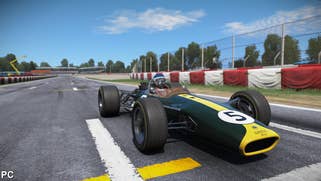
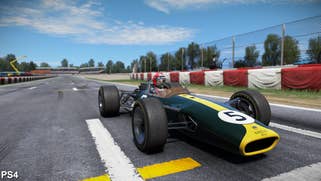
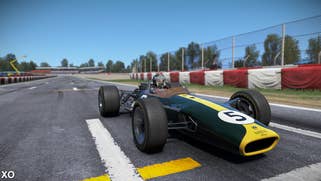
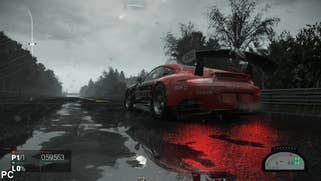
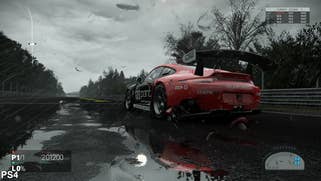
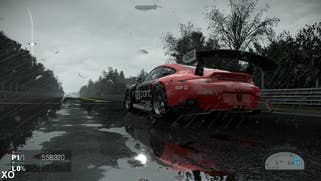
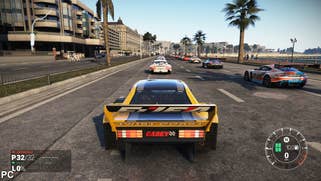
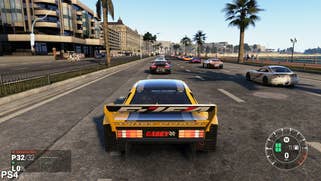


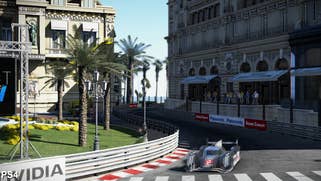


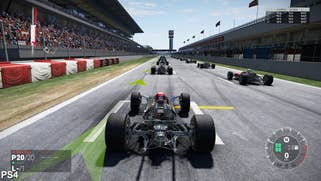

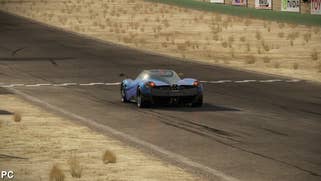
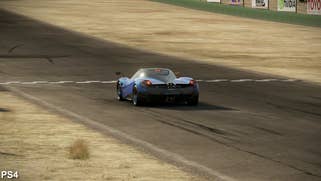


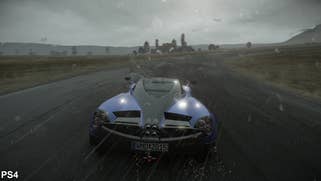
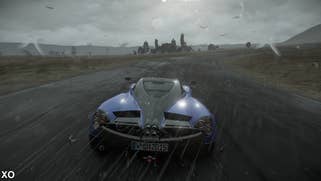
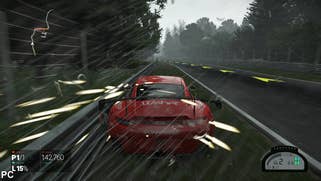
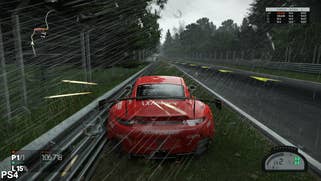
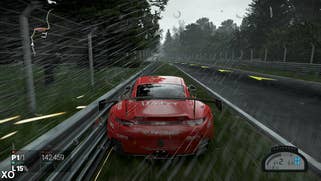
The good news is that PS4 and Xbox One's geometry, track detail and textures use many elements between the PC's medium and high setting. For tracks like the Circuit de Catalyuna, texture resolution on concrete floors is extremely sharp on console; an exact pixel match for the PC's top setting based on our zoomer gallery. Likewise, skid mark details, dirt, and white line overlays are equivalent between all three versions - though maps may vary in quality off the track.
Unfortunately, texture filtering isn't a high point for Project Cars. Ground textures on console make use of what appears a match for PC's 4x anisotropic filtering mode, though PS4 produces blurrier results than Xbox One overall. It's not a concern when a race kicks off, but waiting at a starting grid shows these crisp textures tailing off sharply in quality within a few metres - especially on Sony's console. PC surges forward here with its top-end 16x setting, and circuits like Willow Springs International Raceway benefit hugely from an ultra grass setting, increasing the range at which small foliage is rendered (where consoles use the PC's low setting).
On tracks with clear skies this is the extent of the perceptible difference between PC and console. Switching to a rainy setting tells a very different story, and it's here that we see how far PS4 and Xbox One fall behind the PC's ultra presets. To start with effects, both consoles drop the number of concurrent particles (such as sparks when grinding against a barrier) massively compared to PC. Alpha transparencies also see a drop-off in quality, with splash effects running at a lower resolution that produces visible aliasing on a car's spoiler. On console, this places us between low and medium in the 'particle density' category, while cube-map reflections (as seen in puddles or on a car's bonnet) run equivalent to the lowest resolution possible on PC. Overall, these reflections are a rough spot if you slow down to look, but rarely register as an issue during an actual race.
Barring these three dips into the PC's lower end settings, the rest of the console conversion is impressive. Shadow cascade maps are applied across the track, and though short of the PC's sharpest method, another helpful insider post suggests PS4 and Xbox One run at 1024x4096 shadow resolutions. This is on par with the medium setting on PC, albeit with a match for the high preset's 32-bit precision and four spot shadows. Surprisingly there isn't much to divide the three versions with the chase camera in tow, even at this hybrid setting. However, as spotted in the hands-on build, Xbox One produces aliased shadows while in cockpit view that aren't noticed on PS4.
Alternative analysis:
As established in our earlier analysis, PS4 does also have an advantage in performance. To re-cap quickly, Project Cars' read-out is typically 60fps in its career mode, with tearing and drops below 50fps once rain kicks in. Stress-tests also show a PS4 advantage once 30+ cars are engaged, while Microsoft's platform takes a bigger hit on hectic races with heavy alpha effects. Tearing is constant in these 30-40fps stress-test scenarios, but in the interest of keeping render times as close as possible to the 16.67ms target, dropping v-sync helps to keep the visual update as rapid as possible - if at a cost to image quality.
With regards PC optimisation, the state of performance is uneven between the two major GPU vendors right now. As it stands, there is a trend of AMD cards falling short of their Nvidia's equivalents; even the top-tier R9 290X reportedly struggling against a lowly GTX 760 at 1080p and high settings. We carried out a very quick replay test using the R9 290X and the GTX 970 - two pretty closely matched cards - finding that the Nvidia advantage in one specific scene was a mammoth 77 per cent, with generally poor performance on the Radeon card overall. Based on the results Slightly Mad has achieved with AMD hardware on console, clearly the codebase isn't badly optimised for GCN hardware, suggesting a driver issue is to blame. There's a glimmer of hope in AMD's recent response to the issue, and the team is apparently working on a solution.
Looking at the Nvidia side, the full-fat Project Cars experience is very much designed with top-end machines in mind, and even our standard test setup struggles to go all-out. A top-end card like the GTX 780 Ti or GTX 980 (backed by a Core i7-3770K PC and 16GB of RAM) shows a 60fps return at high settings during clear weather - though just like the console editions it drops as soon as rain effects come into play. The frame-rate is cleaved in half to 30fps on a soaked Azure Circuit here, especially once all 44 rival cars are in view. Dropping all settings to high and reining the car count in to a more palatable 20 vehicles brings us back into locked 60fps territory. It's a compromise that sits well with the career mode, especially as it encourages races of this size by default.

Project Cars: the Digital Foundry verdict
Slightly Mad Studios' racer leaves a high watermark for Polyphony Digital and Turn 10 to match in the coming years. Crucially, both console versions get the attention they deserve, and between the huge car count, dynamic weather and use of PhysX, both PS4 and Xbox One retain many of the PC's version's best features. They aren't perfect; 60fps isn't a lock and bouts of tearing flare up in both - but Project Cars' ambition still vaults it ahead of most racers in the console space. And between the two, though many settings are matched Sony's platform is the easy pick due to its sturdier frame-rate and its native 1080p resolution.
It's something of a cliché to put PC in pole position, but in this case it needs extra emphasis. The higher grade particle effects, reflections and superior car models bring an obvious difference over what PS4 and Xbox One achieve. By comparison it's one of the starker contrasts next to current-gen releases - though the hardware needs to be there to back it. In an ideal scenario Project Cars requires a top-end Nvidia card slotted into an i7 PC, both of which give us a handle on high and ultra settings - upstaging PS4 and Xbox One on almost every visual point. However, there's scalability here too if you need it - using approximate console quality settings, a GTX 750 Ti can produce very similar results to the PS4 game. However, a good amount of CPU power is required to run the game - a Core i5 is needed on vehicle-heavy races to hit 60fps [UPDATE 5:58pm: We've updated this article with revised CPU testing: our test rigs were altered after yesterday's DX12 benching - the reality is that a Core i3 processor clearly struggles on packed races in Project Cars - the game is CPU-bound here, even with a GTX 750 Ti].
With plottings of a sequel already underway, Project Cars' console debut creates some eager expectations around the team's next step. We're intrigued to see what future patches bring to this release for example; whether PS4's ghosting issue will remain as-is, or if a toggle is a planned for the already exhaustive visual effects menu. Just as intriguing is the state of the Wii U version - an unusual third party pledge for the platform right now, though it's one we hope to see come to fruition, if only to see how much of the core experience remains intact for a game that exploits high-end hardware.










